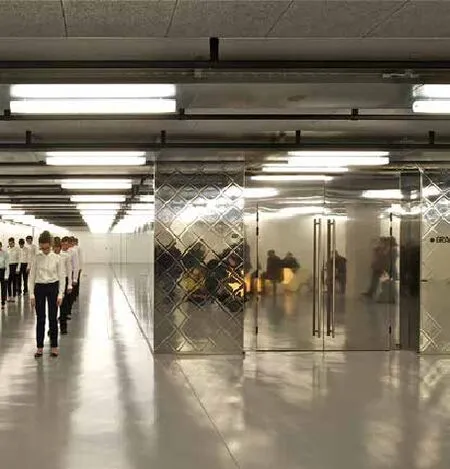La Gaîté Lyrique – Digital Art Center
巴黎GaîtéLyrique剧院准备转型,是为数字艺术和当代音乐创造向公众和艺术家开放的场馆,设立传播、制作和创作空间。
我们的目标是创造一个“宽容”的场所,包容一切随意、不可思议的事物,一处定位自己而又不预定义任何事物的场所,实现相遇者的融合,打破数字艺术、当代音乐和公众与艺术家之间新交流模式的障碍。我们确定了两种类型的空间,并为每个空间设想了一个完美的支撑:展示空间 这些是本项目的三大主要组成:大礼堂、媒体剧院和会议室。所有这些空间可以根据音乐、图片或舞台活动对自己进行重新的布置,并按照双层基础框架进行设计,这种框架赋予的是开放式的场所,场所内没有预先设定表演者与观众之间的关系,从而带来一种新的体验形式。
呼吸空间 围绕结构轮廓,该项目由透气性和弹性更佳的空间组成。这些空间将承担接待、展览、咖啡厅、休息室、媒体播放和艺术家专用区等职能。每一个组成的设计在时间上是不断发展的,在空间上是移动的,在其外观、能力及与其他功能组成的联系上,尽可能地保持灵活性。
'éclaireuse'单元 这个互动原则一旦确定,那么问题将转向确保真正的移动性,例如能够轻松完成场馆的转变。‘éclaireuse’单元发挥作用,保证了这种移动性和无尽的发明。它们由多个小规模的单元组成,利用技术将其集中到一起,可供艺术家和公众进行创作或者展示使用,并根据场馆充满活力的节奏来构建和解构众多场景。
这些单元的大小如货柜一般,采用可移动设计,以体现其各种形式,并在可能的情况下表达游牧主义这一概念。
The Gaîté Lyrique theatre in Paris is up for conversion to create a venue for the digital arts and contemporary music, open to both the public and artists, with spaces for diffusion, production and creation.
Our objective was to create a ‘permissive’ place that includes whatever is random and unexpected, a place that def i nes itself without predef i ning everything, that enables encounters in fusion and breaks down barriers between the digital arts, the music of today and new modes of exchange between the public and artists.
We identif i ed two types of space, and imagined an ideal support for each of them:
Presentation spaces: These are the three main volumes of the project: the main auditorium, the media theatre and the conference room. All of these spaces lend themselves to reconf i guration for sound, image or stage events, and are designed as double envelopes which define open-ended places that never predetermine the performer-spectator relationship and thus enable new forms of experimentation.
Breathing spaces: Around the structuring contours, the programme comprises spaces that are more permeable and elastic. They assume functions such as reception, exhibitions, café, foyers,mediathèque, and spaces to be used by artists. Each of these sub-sets is designed to evolve in time,to move in space, and to be as fl exible as possible in its surface areas, capacities and links with other functional sets.
The ‘éclaireuse’ modules: Once this interacting principle had been def i ned, the problem was to ensure real mobility such as would enable the venue to evolve easily. The role of the ‘éclaireuse’ modules ensures this mobility and endless invention. They are comprised of small modules, concentrated in terms of technique, to be used by both the artists and the public for creation or presentation, and which construct and de-construct a multitude of scenographies scanned by the living rhythm of the venue.
These modules are the size of a container and are designed to move so as to embody by their form and possible functions the notion of nomadism.









